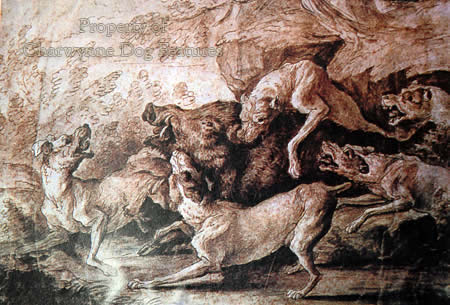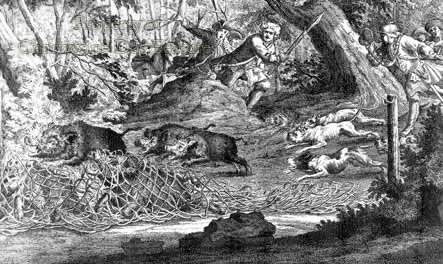833 BOAR-CONTROL -THE BOAR LURCHER
BOAR LURCHERS
by David Hancock
 If you want a humane method of controlling wild boar in England, ancient ways have much to recommend them. Before a wild boar harms a child, a likely occurrence if a sow is accompanied by piglets, some form of control makes good sense. Shooting wild boar is not easy and a wounded boar is doubly dangerous. Although ignorant do-gooders would never sanction it, boar-hounds, or boar-lurchers, seizing the boar by the ear for immediate despatch by humane-killer is a kinder option. Our distant ancestors knew the value of such seizing dogs; we have unthinkingly pursued the shooting method - and that is not wise - or the most humane. Some dogs in such dangerous work might well get killed - that is the nature of such a form of control.
If you want a humane method of controlling wild boar in England, ancient ways have much to recommend them. Before a wild boar harms a child, a likely occurrence if a sow is accompanied by piglets, some form of control makes good sense. Shooting wild boar is not easy and a wounded boar is doubly dangerous. Although ignorant do-gooders would never sanction it, boar-hounds, or boar-lurchers, seizing the boar by the ear for immediate despatch by humane-killer is a kinder option. Our distant ancestors knew the value of such seizing dogs; we have unthinkingly pursued the shooting method - and that is not wise - or the most humane. Some dogs in such dangerous work might well get killed - that is the nature of such a form of control.
It would be good to see appropriate recognition for the boar-lurchers or hunting mastiffs, whether described as docgas, bandogges, seizers, holding dogs, pinning dogs, perro de presas, filas, bullenbeissers or leibhunde. They should at least be respected for their past bravery and bred to the design of their ancestors. A big game hunting breed like the Mastiff of England seems prized nowadays solely for its weight and size. The Englische Dogge ('dogge' then meant mastiff) was once famous throughout central Europe as a hunting mastiff par excellence. It is a fact that, in the boar-hunting field in central Europe in the period 1500 to 1800AD, many more catch-dogs were killed than the boars being hunted. In those days there was a saying in what is now Germany that if you wanted boars' heads you had to sacrifice dogs' heads. 
Many types of dog have been used in the boar-hunt, with only one modern breed, the Great Dane or German Mastiff, directly inheriting the boarhound mantle. Hounds of the pack were often regarded as too precious to be risked in the final moments of the boar-hunt, so more coarsely-bred dogs were used 'at the kill', being considered expendable. These were variously described as catch-dogs, bandogges, alauntes and seizers. They were recklessly brave, remarkably agile, extraordinarily determined and admirably athletic. A better name for them would be 'boar-lurchers'; they were never intended to be a breed, they were never uniformly bred and nearly always owned by the lower classes, who were sometimes paid or rewarded for doing so, as a contribution to the hunt.
In England, in the reign of Henry the Second, the wild boar was hunted with hounds and spears in many wooded areas, from the Forest of Dean to Warwickshire and beyond. King James hunted the boar at Windsor, this being described as "a more dangerous amusement than it was likely he could find any pleasure in". Turbervile writing in the late 16th century, recorded that hounds accustomed to running the boar were spoiled for game of scent less strong. They were alleged to be less inclined to stoop to the scent of deer or hare and disinclined to pursue a swifter quarry which did not turn to bay when out of breath. The East India Company introduced hunting dogs from England into India in 1615; on one occasion a mastiff from England shaming "the Persian dogs" at a boar kill.
In central Europe there were once huge dogs used in the boar hunts of the great forests of what is now Germany, western Poland and the Czech Republic. They were known as 'hatzruden' (literally big hunting dogs), huge rough-haired crossbred dogs, supplied to the various courts by peasants. They were the "expendable" dogs of the boar hunt, used at the kill. The nobility however bred the smooth-coated 'sauruden' (boar hounds), and 'saupacker' (literally, member of a pack used for hunting wild boar). The 'saufanger' (boar seizer) was the catch-dog or hunting mastiff.
The 'sauruden' were the equivalent, in the late 18th century, of the hunting alaunts of the 15th century, with the Bullmastiff being the modern equivalent of the "alaunts of the butcheries". The specialist 'leibhund', literally 'body-dog', was the catch-dog used to close with the boar and seize it. I believe it is perfectly reasonable to regard the modern breed called the Great Dane (in English-speaking countries) or Deutsche Dogge (German mastiff), although not as huge when a boarhound, as the inheritor of the saurude or boarhound mantle.
The true boarhound, a hound of the chase or chien courant, as opposed to a huge crossbred dog once used at the killing of the boar, deserves our respect. Such a hound was required to pursue and run down one of the most dangerous quarries in the hunting field. It needed to be a canine athlete, have a good nose, great determination and yet not be too hot-blooded. Both the Fila Brasileiro and the Dogo Argentino have been used in the boar hunt in South America. American Bulldogs are still used as catch-dogs on feral pig in the USA, with Bullmastiff crosses being favoured in New Zealand. Such a dog must have immense perseverance allied to great agility.
In our modern so-called more tolerant society, such powerful determined hunting dogs are stigmatized and even banned in some allegedly liberal countries. These are not happy times for hunting dogs bred by man to be determined, strong and recklessly brave. Sadly, they are also irreplaceable. Prized for several millennia for their dash and bravery, powerful sporting dogs are now under suspicion just because they are powerful. We may not want strapping courageous dogs to pull down big game for us any more but they are part of our sporting heritage and deserve our support. We never lacked support from them.
The great forests of central Europe provided endless opportunities for hunting. In the 19th century the pursuit of wild animals with hounds was conducted on a vast scale. In France there were over 350 packs of hounds. In 1890 the Czar of Russia organised a grand fourteen day hunt in which his party killed 42 European bison, 36 elk and 138 wild boar. In many of these hunts, scenthounds, sighthounds, running mastiffs or par force hounds (the true gazehounds) and hunting mastiffs (often held on the leash until needed at the kill and called 'bandogges' by the Saxons) were used in the same hunt.
The ancient Greeks, Gaston Phoebus in the 14th century, the Bavarians in the 17th century and the Czars in the 19th century used hunting dogs of different types in unison according to function. Sighthounds, scenthounds and hunting mastiffs were used together and not hunted separately, unlike our more specialist packs. Boarhounds could therefore be the loose term to describe all hounds on a boar hunt, whatever their function in the chase and kill. Casual researchers can therefore look at a painting of a boar hunt or read accounts of one and jump to all sorts of false conclusions about what boarhounds could look like in past times. .jpg)
The invention of firearms brought not just dramatic advantages to hunter-sportsmen but a substantially reduced risk to their lives. This very much lessened their dependence, in some forms of hunting, on determined courageous dogs. We live in times when powerful dogs brave enough to tackle boar, bull and bison are banned in some countries, not because of any current misdeeds, but purely because of their past as a type of dog. In modern times too a dog that can single-handedly catch a hare is valued less than a dog that can only retrieve a dead rabbit.
The recklessly brave dogs which closed with the boar in the medieval hunt were boar-lurchers in today's phraseology. The broad-mouthed dogs that survive, the once coarsely-bred mastiff-types developed by show-men into distinct breeds and now being ruined in today's show rings, have a remarkable heritage and deserve all the respect we can afford them. They might still have a use in controlling wild boar both humanely and effectively.